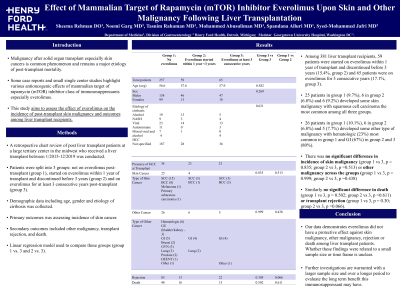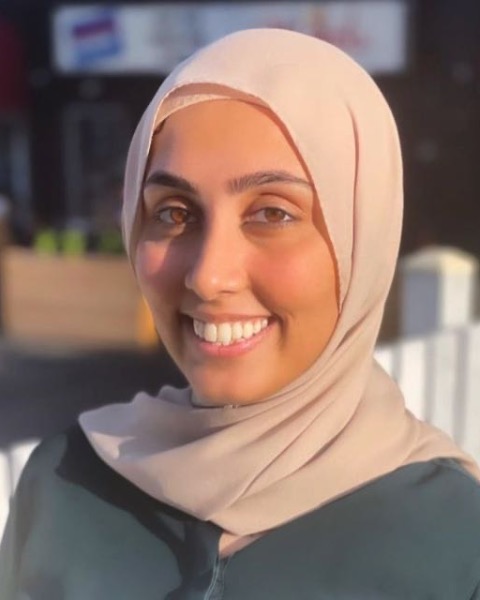Monday Poster Session
Category: Liver
P2886 - Effect of Mammalian Target of Rapamycin (mTOR) Inhibitor Everolimus Upon Skin and Other Malignancy Following Liver Transplantation
Monday, October 28, 2024
10:30 AM - 4:00 PM ET
Location: Exhibit Hall E

Has Audio

Sheema Rehman, DO
Henry Ford Health
Detroit, MI
Presenting Author(s)
Sheema Rehman, DO1, Noemi Garg, MD2, Tasnim Rahman, MD1, Maria Jamil, MD1, Mohammed Abusuliman, MD1, Spandana Alluri, MS, MD3, Wesam Almasri, BS4, Renieh Nabaty, MD5, Syed-Mohammed Jafri, MD1
1Henry Ford Health, Detroit, MI; 2MedStar Georgetown University Hospital, Washington, DC; 3Henry Ford Health, West Bloomfield, MI; 4Oakland University William Beaumont School of Medicine, Rochester Hills, MI; 5Henry Ford Hospital, Detroit, MI
Introduction: Malignancy after solid organ transplant especially skin cancers is common phenomenon. Some case reports and small single center studies highlight various antioncogenic effects of mammalian target of rapamycin (mTOR) inhibitor class of immunosuppressants especially everolimus. This study aims to assess the incidence of post transplant skin malignancy and outcomes among liver transplant recipients on everolimus.
Methods: A retrospective chart review of liver transplant recipients transplanted at a large tertiary center between 1/2015-12/2019 was conducted. Patients were split into 3 groups: not on everolimus post transplant (group 1), started on everolimus within 1 year of transplant and discontinued before 3 years (group 2) and on everolimus for at least 3 consecutive years (group 3). Demographic data including age and gender were collected with primary outcome assessing the incidence of skin cancer post transplant. Secondary outcomes assessed other post transplant malignancies including non-hepatic gastrointestinal malignancy, transplant rejection and death.
Results: Among 381 liver transplant recipients, 67% were in group 1 (n=257), 15% in group 2 (n=59), 17% in group 3 (n=65). 25 patients in group 1 (9.7%), 4 in group 2 (6.8%) and 6 (9.2%) in group 3 developed some skin malignancy with squamous cell carcinoma the most common among all three groups (group 1 vs 3, p =0.835; group 2 vs 3, p =0.513). 26 patients in group 1 (10.1%), 6 in group 2 (6.8%) and 5 (7.7%) developed some other type of malignancy, and among other malignancies, hematologic was most common in group 1 (n=6, 23%) and non-hepatic gastrointestinal was most common in group 2 (n=4, 67%) and 3 (n=4, 80%). There was no significant difference in incidence of skin malignancy (group 1 vs 3, p = 0.835; group 2 vs 3, p =0.513), death (group 1 vs 3, p = 0.502; group 2 vs 3, p =0.611) or transplant rejection among the three groups (group 1 vs 3, p = 0.305; group 2 vs 3, p =0.066).
Discussion: Our data demonstrates everolimus did not have a protective effect against skin malignancy, other post transplant malignancies, transplant rejection or mortality in liver transplant patients. The data demonstrated that the duration of evrolimus therapy also had no effect on these variables. Whether these study findings were related to short duration of therapy or to a small sample size is unclear. Further investigations are warranted over a longer period of time and with other mTOR agents.
Note: The table for this abstract can be viewed in the ePoster Gallery section of the ACG 2024 ePoster Site or in The American Journal of Gastroenterology's abstract supplement issue, both of which will be available starting October 27, 2024.
Disclosures:
Sheema Rehman, DO1, Noemi Garg, MD2, Tasnim Rahman, MD1, Maria Jamil, MD1, Mohammed Abusuliman, MD1, Spandana Alluri, MS, MD3, Wesam Almasri, BS4, Renieh Nabaty, MD5, Syed-Mohammed Jafri, MD1. P2886 - Effect of Mammalian Target of Rapamycin (mTOR) Inhibitor Everolimus Upon Skin and Other Malignancy Following Liver Transplantation, ACG 2024 Annual Scientific Meeting Abstracts. Philadelphia, PA: American College of Gastroenterology.
1Henry Ford Health, Detroit, MI; 2MedStar Georgetown University Hospital, Washington, DC; 3Henry Ford Health, West Bloomfield, MI; 4Oakland University William Beaumont School of Medicine, Rochester Hills, MI; 5Henry Ford Hospital, Detroit, MI
Introduction: Malignancy after solid organ transplant especially skin cancers is common phenomenon. Some case reports and small single center studies highlight various antioncogenic effects of mammalian target of rapamycin (mTOR) inhibitor class of immunosuppressants especially everolimus. This study aims to assess the incidence of post transplant skin malignancy and outcomes among liver transplant recipients on everolimus.
Methods: A retrospective chart review of liver transplant recipients transplanted at a large tertiary center between 1/2015-12/2019 was conducted. Patients were split into 3 groups: not on everolimus post transplant (group 1), started on everolimus within 1 year of transplant and discontinued before 3 years (group 2) and on everolimus for at least 3 consecutive years (group 3). Demographic data including age and gender were collected with primary outcome assessing the incidence of skin cancer post transplant. Secondary outcomes assessed other post transplant malignancies including non-hepatic gastrointestinal malignancy, transplant rejection and death.
Results: Among 381 liver transplant recipients, 67% were in group 1 (n=257), 15% in group 2 (n=59), 17% in group 3 (n=65). 25 patients in group 1 (9.7%), 4 in group 2 (6.8%) and 6 (9.2%) in group 3 developed some skin malignancy with squamous cell carcinoma the most common among all three groups (group 1 vs 3, p =0.835; group 2 vs 3, p =0.513). 26 patients in group 1 (10.1%), 6 in group 2 (6.8%) and 5 (7.7%) developed some other type of malignancy, and among other malignancies, hematologic was most common in group 1 (n=6, 23%) and non-hepatic gastrointestinal was most common in group 2 (n=4, 67%) and 3 (n=4, 80%). There was no significant difference in incidence of skin malignancy (group 1 vs 3, p = 0.835; group 2 vs 3, p =0.513), death (group 1 vs 3, p = 0.502; group 2 vs 3, p =0.611) or transplant rejection among the three groups (group 1 vs 3, p = 0.305; group 2 vs 3, p =0.066).
Discussion: Our data demonstrates everolimus did not have a protective effect against skin malignancy, other post transplant malignancies, transplant rejection or mortality in liver transplant patients. The data demonstrated that the duration of evrolimus therapy also had no effect on these variables. Whether these study findings were related to short duration of therapy or to a small sample size is unclear. Further investigations are warranted over a longer period of time and with other mTOR agents.
Note: The table for this abstract can be viewed in the ePoster Gallery section of the ACG 2024 ePoster Site or in The American Journal of Gastroenterology's abstract supplement issue, both of which will be available starting October 27, 2024.
Disclosures:
Sheema Rehman indicated no relevant financial relationships.
Noemi Garg indicated no relevant financial relationships.
Tasnim Rahman indicated no relevant financial relationships.
Maria Jamil indicated no relevant financial relationships.
Mohammed Abusuliman indicated no relevant financial relationships.
Spandana Alluri indicated no relevant financial relationships.
Wesam Almasri indicated no relevant financial relationships.
Renieh Nabaty indicated no relevant financial relationships.
Syed-Mohammed Jafri: Gilead, Takeda, Abbvie, Intercept, VectivBio – Advisor or Review Panel Member, Speakers Bureau.
Sheema Rehman, DO1, Noemi Garg, MD2, Tasnim Rahman, MD1, Maria Jamil, MD1, Mohammed Abusuliman, MD1, Spandana Alluri, MS, MD3, Wesam Almasri, BS4, Renieh Nabaty, MD5, Syed-Mohammed Jafri, MD1. P2886 - Effect of Mammalian Target of Rapamycin (mTOR) Inhibitor Everolimus Upon Skin and Other Malignancy Following Liver Transplantation, ACG 2024 Annual Scientific Meeting Abstracts. Philadelphia, PA: American College of Gastroenterology.
